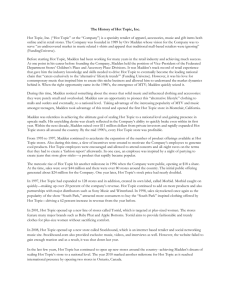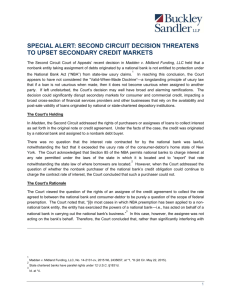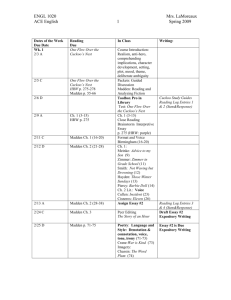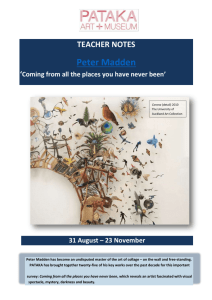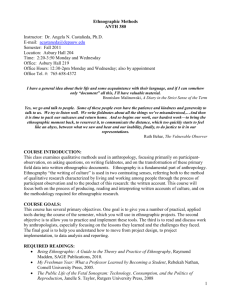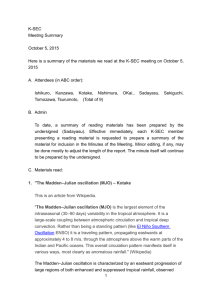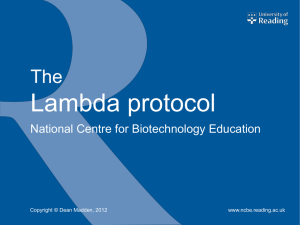Liberty's Call: Richard Robert Madden's Voice in the Anti
advertisement
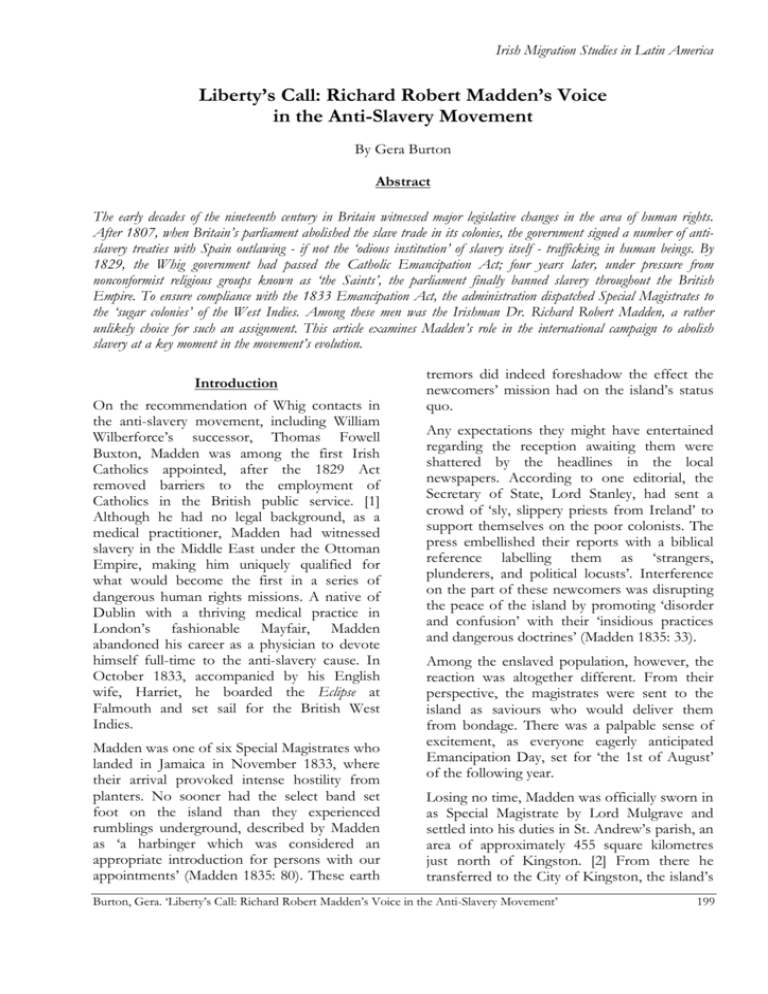
Irish Migration Studies in Latin America Liberty’s Call: Richard Robert Madden’s Voice in the Anti-Slavery Movement By Gera Burton Abstract The early decades of the nineteenth century in Britain witnessed major legislative changes in the area of human rights. After 1807, when Britain’s parliament abolished the slave trade in its colonies, the government signed a number of antislavery treaties with Spain outlawing - if not the ‘odious institution’ of slavery itself - trafficking in human beings. By 1829, the Whig government had passed the Catholic Emancipation Act; four years later, under pressure from nonconformist religious groups known as ‘the Saints’, the parliament finally banned slavery throughout the British Empire. To ensure compliance with the 1833 Emancipation Act, the administration dispatched Special Magistrates to the ‘sugar colonies’ of the West Indies. Among these men was the Irishman Dr. Richard Robert Madden, a rather unlikely choice for such an assignment. This article examines Madden’s role in the international campaign to abolish slavery at a key moment in the movement’s evolution. Introduction On the recommendation of Whig contacts in the anti-slavery movement, including William Wilberforce’s successor, Thomas Fowell Buxton, Madden was among the first Irish Catholics appointed, after the 1829 Act removed barriers to the employment of Catholics in the British public service. [1] Although he had no legal background, as a medical practitioner, Madden had witnessed slavery in the Middle East under the Ottoman Empire, making him uniquely qualified for what would become the first in a series of dangerous human rights missions. A native of Dublin with a thriving medical practice in London’s fashionable Mayfair, Madden abandoned his career as a physician to devote himself full-time to the anti-slavery cause. In October 1833, accompanied by his English wife, Harriet, he boarded the Eclipse at Falmouth and set sail for the British West Indies. Madden was one of six Special Magistrates who landed in Jamaica in November 1833, where their arrival provoked intense hostility from planters. No sooner had the select band set foot on the island than they experienced rumblings underground, described by Madden as ‘a harbinger which was considered an appropriate introduction for persons with our appointments’ (Madden 1835: 80). These earth tremors did indeed foreshadow the effect the newcomers’ mission had on the island’s status quo. Any expectations they might have entertained regarding the reception awaiting them were shattered by the headlines in the local newspapers. According to one editorial, the Secretary of State, Lord Stanley, had sent a crowd of ‘sly, slippery priests from Ireland’ to support themselves on the poor colonists. The press embellished their reports with a biblical reference labelling them as ‘strangers, plunderers, and political locusts’. Interference on the part of these newcomers was disrupting the peace of the island by promoting ‘disorder and confusion’ with their ‘insidious practices and dangerous doctrines’ (Madden 1835: 33). Among the enslaved population, however, the reaction was altogether different. From their perspective, the magistrates were sent to the island as saviours who would deliver them from bondage. There was a palpable sense of excitement, as everyone eagerly anticipated Emancipation Day, set for ‘the 1st of August’ of the following year. Losing no time, Madden was officially sworn in as Special Magistrate by Lord Mulgrave and settled into his duties in St. Andrew’s parish, an area of approximately 455 square kilometres just north of Kingston. [2] From there he transferred to the City of Kingston, the island’s Burton, Gera. ‘Liberty’s Call: Richard Robert Madden’s Voice in the Anti-Slavery Movement’ 199 Vol. 5, n°3 (November 2007) commercial and administrative centre, when this important region was placed under his jurisdiction. Madden’s tenure was marked by illness, controversy, and violence. Within nine months of their arrival, yellow fever and other tropical diseases caused the untimely demise of four of the special magistrates who had accompanied Madden on the Eclipse. Evidently, the Irishman’s medical training and standards of hygiene inoculated him from the ravages of disease as he adapted to the unfamiliar climate. On what he later described as the proudest day of his life (Madden 1891), Madden was present for the historic Emancipation Day Proclamation, delivered by Lord Mulgrave, in Spanish Town, Jamaica, on 1 August 1834. Far from disturbing the peace of the island as the authorities had feared, slaves celebrated the occasion with church services and ‘a quiet and grateful piety.’ [3] According to the provisions of the Emancipation Act, by way of compensation, the government had earmarked £20 million (more than £800 million in today’s currency) to be paid to former slave owners for loss of ‘property’. Slaves younger than six years of age were to be freed, while those six years and older were required to serve a term of apprenticeship designed to teach them how to behave in freedom, or, as the Act stipulated, ‘to accustom themselves, under appropriate restraints, to the responsibilities of the new status’ (Temperley 1972: xi). Under threat of corporal punishment, house slaves were required to serve a period of four years; praedial slaves had to serve a period of six years, in what amounted to little more than a system of modified slavery. During one of his numerous trips around the island, Madden set out for St. Mary’s Parish to find the location of a small plantation property known as Marley that had once belonged to a distant relative long since deceased. At the end of an exhausting day’s ride in the verdant mountains, whose heavily wooded areas and limestone soil had sustained countless runaway slaves, he discovered what appeared to be the abandoned remains of the old Marley plantation. Making his way along the narrow, 200 mostly overgrown path, he encountered three women, former slaves, who had been living in the dilapidated old house for many years. To his astonishment, the two younger, middle-aged women turned out to be the daughters of Madden’s great-uncle, Theodosius Lyons, the previous plantation owner. He could even see a strong family resemblance, and the elderly woman was their mother. As the story unfolded, the sisters described how, following the sudden death of the plantation manager, their younger brother was sold to pay off the debts of the estate. Deeply moved by these revelations, Madden offered the family what little he could by way of financial assistance. On the tiny Derry plantation nearby, he discovered the exact site where, forty years earlier, one of his uncles, old Garrett Forde, was laid to rest. With a sense of Shakespearian irony, he observed that the soil covering the spot had begun to sprout the planter’s beloved sugar canes. Undoubtedly, the unforeseen encounter with his Jamaican relatives had a profound impact on Madden, infusing him with an even greater desire to eradicate slavery in all its forms (Madden 1891). Much to the dismay of colonial officials preoccupied with the ‘sacred rights of property’, as Special Magistrate, Madden viewed emancipated slaves as British subjects, entitled to all the protections enjoyed by white subjects under the law. The duties of the Special Magistrates under the 1833 Abolition Act were ‘extensive but vague’ (Burn 1937: 203); they had exclusive jurisdiction over relations between apprentices and their former masters. The arduous workload involved regular tours of inspection on horseback over a rough terrain, frequently mountainous, covering a radius of as much as thirty miles. Duties included regular visits to jails and workhouses. The Special Magistrates were required to fix the value of slaves who wished to purchase their freedom. They also had to find suitable locations to hold court. When there was a dispute, Madden insisted upon equal treatment of apprentices in his court, refusing to hear cases in which coercion had Burton, Gera. ‘Liberty’s Call: Richard Robert Madden’s Voice in the Anti-Slavery Movement’ Irish Migration Studies in Latin America been used to bring the accused before him. In response, he faced obstruction by the powerful Council of Kingston, which maintained its own police force and resented the imposition of Special Magistrates by the London government. In the course of his duties, Madden befriended Benjamin Cochrane, otherwise known as Anna Moosa or Moses. A native Arabic speaker and son of a Mandinka chief, Anna Moosa was a skilled doctor with a practice in Kingston where he administered popular medicine, demonstrating considerable expertise with medicinal plants. Madden also struck up a friendship with Aban Bakr Sadiki (Al-Saddiq), a Muslim scholar and native of a region bordering Timbuktu, who had been kidnapped thirty years earlier, transported to Jamaica, and sold into slavery. Bakr was noted for his Arabic penmanship and for the accounting ability that became invaluable to the plantation owner who claimed him as his property. To Madden he was ‘as much a nobleman in his own country as any titled chief is in ours’ (Madden 1835: 158). Expressing his regard for this extraordinary individual, Madden later wrote, ‘I think if I wanted advice in any important matter in which it required extreme prudence and a high sense of moral rectitude to qualify the possessor to give counsel, I would as soon have recourse to the advice of this poor negro as any person I know’ (Madden 1835: 158). With some difficulty, he managed to secure Bakr’s manumission and passage back to Sierra Leone. [4] Inevitably, Madden’s activities led to clashes with employers of apprentices. On one occasion, when a dispute between a planter and his apprentice erupted in his court, the irate employer threatened to have him ‘tarred and feathered’. Without the support of local law enforcement, his situation became untenable. Refusing to be intimidated, he was obstructed and assaulted on a Kingston street, until two other Special Magistrates intervened and threatened to call in the troops. Eventually, Madden was forced to resign his position and return to London noting, ‘I found the protection of the negro incompatible with my own’ (Madden 1891: 72). Upon returning to London, Madden published the two-volume A Twelvemonth Residence in the Island of Jamaica (1835), using as a device an epistolary format whose addressees included prominent literary figures, such as the poet, Thomas Moore. The book had a considerable effect on public opinion in Britain (Burn 1937: 221). The work prompted the government to establish a select committee whose membership included Daniel O’Connell, ‘to inquire into the working of the apprenticeship system in the colonies’, at which Madden testified that, essentially, the apprenticeship system was slavery in another form. Along with two other Special Magistrates, he described the difficulties and abuses inherent in the Jamaican system, but went further than the others in condemning it as a failure, offering ‘no security for the rights of the negro, no improvement in his intellectual condition’. His efforts, along with those of Joseph Sturge and members of the anti-slavery movement, led to the early abolition of the apprenticeship system in 1838, two years prior to the date fixed by the Emancipation Act. Apart from documenting the inoperability of apprenticeship, the 1835 work is replete with descriptions of Jamaica’s flora and fauna based on the author’s observations. [5] The appendix to the London edition also provides an insight into Madden’s views of US policy. Written in the form of satirical verse, the following lines reflect Irish opinion as articulated by Daniel O’Connell: O Hail! Columbia, happy land! The cradle land of liberty! Where none but negroes bear the brand, Or feel the lash of slavery. Following the signing of the Anglo-Spanish treaty of 1835, Madden prepared to set sail once again, this time for Havana, Cuba, the centre of the slave trade. Even before he set foot on the island in the summer of 1836, the Irishman’s appointment by the Colonial Office under Lord Glenelg ‘for his merit and character’ (Madden 1891: 75) as Judge Arbitrator and first Superintendent of Liberated Africans caused a flurry of diplomatic activity between Cuba and Spain. Burton, Gera. ‘Liberty’s Call: Richard Robert Madden’s Voice in the Anti-Slavery Movement’ 201 Vol. 5, n°3 (November 2007) Describing Madden as un hombre peligroso, (‘a dangerous man’) based on his abolitionist view and activities in Jamaica, the Captain-General, Miguel Tacón, attempted unsuccessfully to block his appointment. Madden was also appointed Judge Arbitrator on the International Mixed Commission Court for the Suppression of the Slave Trade in Havana under Lord Palmerston at the British Foreign Office. [6] In accordance with the anti-slave trade treaties, slaves from condemned vessels were to be liberated and employed as either free labourers or servants. Since he was charged with securing the safety of emancipados, or freed slaves, Madden was set on a collision course with the ruling saccharocracy. His plan was to transfer the emancipados from captured vessels to British colonies as free labourers. Tacón, however, refused to allow the emancipados to come ashore while awaiting a vessel to transport them to British colonies, on the pretext that they would transmit cholera or some other contagious disease. As Madden clearly pointed out, Tacón had no difficulty allowing enslaved Africans ashore in chains at out-of-the-way places around the Cuban coastline. From the perspective of the Captain-General, only emancipated Africans posed a threat to inhabitants as ‘pestilential persons’ with their capacity to spread ‘a contagion of liberty’ throughout the island. A confidential dispatch from Tacón to the Spanish government confirmed that Madden’s views as an abolitionist unnerved the Captain-General more than any other concern at that time. To obtain an accurate assessment of conditions in Cuba, Madden developed the habit of showing up on plantations unannounced, providing him an opportunity to see beyond the colonial façade of lavish hospitality to invited guests and to refute the so-called ‘benign treatment’ of slaves in Spanish colonies. What he observed remained etched in his memory, as his anguished testimony made clear: ‘So transcendent the evils I witnessed, over all I had ever heard or seen of the rigors of slavery elsewhere, that at first I could hardly believe the evidence of my senses’ (Madden 1891: 77). Some of the more egregious 202 practices he documented were the twenty-hour work day at harvest time and the appalling conditions of the ingenios, or sugar mills, which he described as ‘hells on earth’. Withstanding pressure to turn a blind eye to abuse, he gained powerful enemies and found himself in a lifethreatening situation on at least one occasion. Regardless of the obstacles, the valiant doctor remained fiercely independent, prompting one unscrupulous slave-keeping British official appointee in Havana to declare that he agreed with Lord Sligo’s assertion that ‘he [Madden] wouldn’t agree with an angel from heaven’ (Ó Broin 1971: 95). No episode portrays the nature of the conflict in Cuba more clearly than that surrounding the British vessel Romney. Shortly after his arrival in Cuba, instead of seeing to the break-up of the captured slave ships as stipulated by the 1835 Anglo-Spanish treaty, Madden proposed that these ships be used to accommodate Africans liberated by the Mixed Anglo-Spanish Court until they could be transported to safe locations. Once the Africans were liberated, it was Madden’s responsibility to arrange for their safe passage to neighbouring islands - a sizeable task, given the concerted opposition of powerful interests. Later, he convinced his employer of the need to procure the Romney, a superannuated warship, as a permanent hospital ship to provide accommodation and medical assistance to the men, women, and children rescued from the slave ships. The infuriated Tacón refused to allow the Romney’s crew of free and newly liberated Africans to come ashore, so the vessel remained at anchor in the harbour at Havana. Drawing on his medical expertise, Madden maintained the vessel as a hospital ship whose presence became an affront to the slaveholding oligarchy. Defiantly, the Romney remained anchored in the bay at Havana for almost nine years, long after Madden’s departure, as un baluarte del abolicionismo en el corazón del esclavismo (‘a bulwark of abolition in the heart of slavery’) (Ortiz 1975: 23). As he was preparing to leave Cuba for London, Madden read an article in The Sun newspaper about an incident involving a number of Burton, Gera. ‘Liberty’s Call: Richard Robert Madden’s Voice in the Anti-Slavery Movement’ Irish Migration Studies in Latin America enslaved Africans on board a Cuban schooner, the slave ship Amistad. Under the headline, ‘The Long, Low, Black Schooner’, the article, which included a sketch of the six-year-old, 170-ton vessel ‘of Baltimore clipper build’, reported the arrest and detention of the Africans. On his own initiative, and without prior approval from his employer, Madden immediately sailed for the United States to give key evidence in the case of the captives of the Amistad. In one of the most famous trials of the age, fifty-two Africans were charged with mutiny and murder on board the Amistad as they struggled to overcome and escape their captors. An expert witness with first-hand knowledge of the operation of the Cuban barracones, or slave barracks, Madden visited the Africans in the New Haven County Jail, where he addressed the captives in Arabic. Since he had procured the emancipation of hundreds of Africans and had visited the Misericordia slave barracks in Havana just a few weeks previously on 24 September 1839, he could testify with authority as to the status of those held. The captives had been purchased from Don Pedro Martínez, of Martínez and Company - ‘a notorious house’ one of the largest slave traders in Havana, with slave forts along the coast of Sierra Leone. The prosecuting attorneys argued that the captives were ladinos, the term used on the transportation licence, and had been brought to Cuba before 1820, the year in which the slave trade became illegal. They made the case that, because the accused were slaves before the law changed, they were therefore legally held property. Although translated by US officials as meaning ‘able-bodied’, Madden clarified that, in Cuba, the term ladino was specifically used to denote Africans enslaved before 1820. In his deposition, dated 20 November 1839, he testified that the accused were ‘bona fide bozal negroes quite newly imported from Africa’, or Africans recently kidnapped and transported to Cuba to be sold into slavery, in contravention of the law. His evidence showed that their return to Cuba, as desired by President Van Buren, meant instant death at the hands of interests aligned with the ruling saccharocracy determined to make an example of the captives for would-be insurrectionists (Jones 1987: 109). Madden’s deposition proved that the captives, some of whom were less than 19 years old at the time of the trial, were indeed bozales and were therefore illegally held. Much later, summarising the arguments for the accused, former US President John Quincy Adams stated that this distinction was one of the most important points of the case. [7] The fearless doctor also drew attention to Cuba’s blatant disdain for Spain’s international anti-slavery treaties exemplified by the imposition of a $10 ‘voluntary contribution’, or tax levied on each slave introduced to the island, the proceeds of which flowed into the Captain-General’s coffers. The Amistad affair aroused international interest, threatening to interfere with relations among the major powers, the US, Spain, and England, over jurisdiction. Madden’s role in the case helped strengthen ties between the British and Foreign Anti-Slavery Society and American groups opposed to the ‘odious institution’. Although the Irishman travelled to the United States and gave evidence at his own expense and without prior approval from London, his employer at the Colonial Office, Lord John Russell, later to become Prime Minister, recognising the significance of Madden’s actions, subsequently commended him for his actions in defence of the Amistad captives (Madden 1891). Prior to the events surrounding the Amistad affair, in order to highlight the corrupt practices of the colonial administration in Cuba, Madden wrote a pamphlet entitled ‘Regarding the Slave Trade in Cuba’ (1839), which was published in Boston, receiving much attention. Penned in the form of an open letter to the outspoken, anti-abolitionist Unitarian minister, William Ellery Channing, Madden criticised the role of the US Consul in Havana, Nicholas Trist, in the slave trade. [8] Widely circulated in the United States, the pamphlet denounced not only the Cuban administration but the role of US investment capital in maintaining an abundant supply of slave labour. Madden accused Trist of trafficking in slaves between Cuba and the Burton, Gera. ‘Liberty’s Call: Richard Robert Madden’s Voice in the Anti-Slavery Movement’ 203 Vol. 5, n°3 (November 2007) Republic of Texas under the cover of the US flag. In retaliation, an anonymous correspondent with the pseudonym ‘Calm Observer’ launched a blistering attack on the Irishman, calling into question his credentials and motivation regarding the Amistad captives. [9] literature, Manzano’s narrative did not appear in its original Spanish until 1937, almost one hundred years after the publication of Madden’s translation. In 1849, Madden published a comprehensive account of his experiences in Cuba entitled The Island of Cuba: Its Resources, Progress and Prospects. [12] On 12 June 1840, the world’s first anti-slavery convention in London drew thousands of participants from several countries. The US delegation, numbering in the hundreds, included William Lloyd Garrison, Lucrecia Mott, and Elizabeth Cady Stanton. [10] The official register of delegates lists four representatives of the Hibernian Anti-Slavery Association: Richard Allen, Richard D. Webb, Edward Baldwin, Daniel ‘The Liberator’ O’Connell, and Dr R. R. Madden, recently returned from Cuba. The doctor’s perspective as an eyewitness was particularly valuable, as it ran contrary to De Toqueville’s statements regarding the ‘benign’ nature of slavery in Spanish colonies. On 7 January 1841, Madden embarked for Gambia as Commissioner of Inquiry to conduct an investigation into the operation of slave settlements on the west coast of Africa. What he discovered provoked intense opposition, leading to personal attacks on his character, especially when an unexpected change in the government in London altered the political landscape. His controversial Report to the House of Commons exposed the ‘pawn’ system, in which British merchants took Africans as captives in pawn for debts; when the debts could not be discharged, the pawns lapsed into slavery. Published in 1842, the report also exposed the flouting of the government’s official anti-slavery policy by British companies engaged in supplying the slave trade. Once again, the courageous doctor battled powerful ‘monied interests’, this time with ties to the City of London. In his address, Madden presented a detailed account of the nature and operation of the slave trade in Cuba, published in pamphlet form and circulated widely. He described the blatant disregard for the cédulas (documents) supposedly in effect in Cuba for the protection of slaves as well as the system of coartación, whereby slaves could purchase their freedom in instalments. In fact, regardless of official decrees, at all times slaves remained at the mercy of slaveholders, who were under no obligation to accede to their slaves’ requests for coartación. Also distributed widely that year was Madden’s translation of Juan Francisco Manzano’s poetry and Part I of his autobiography, published as Poems by a Slave in the Island of Cuba (1840). Manzano and Madden had developed a friendship in Havana and, although Juan Pérez de la Riva maintained that Madden was instrumental in procuring his friend’s manumission, I am unable to verify that this was the case. [11] The autobiography broke ground as it was, and remains, the only work of its kind by a slave from a Spanish colony. Considered the foundational work of Cuban 204 When the new government appointed John Forster MP, an affluent West African merchant and slave-trade profiteer, as Chair of a House of Commons committee to investigate the report’s findings, including allegations of his own company’s participation in the illegal slave trade, it became clear that a cover-up was in progress. Committee members challenged Madden’s findings and criticised his methods, so that portions of the report were withheld from the British public. Although the results of Madden’s investigation were undermined by a powerful opposition in the House of Commons, the British and Foreign Anti-Slavery Society expressed its appreciation for ‘the fearless and impartial manner’ in which he had exposed the evils connected with the participation of British merchants in the slave trade and the ‘pawn’ system. The Committee further referred to the ‘unjust attacks to which [he had] been subjected by parties implicated in the transactions Burton, Gera. ‘Liberty’s Call: Richard Robert Madden’s Voice in the Anti-Slavery Movement’ Irish Migration Studies in Latin America exposed and which [he had] so successfully refuted’ (Madden 1891: letter dated 31 March 1843). Perhaps the best vindication of Madden’s findings came from the veteran antislavery campaigner, Thomas Clarkson. Referring to the ‘cruel warfare [he had] to sustain’, the 83-year-old Clarkson acknowledged his victory over the ‘vile and servile agents’ and ‘unprincipled men who endeavored to thwart [him] in all [his] proceedings’ (Madden 1891: 117, letter dated 10 April 1843). Sponsored by Buxton, the 1843 Slave Act extended the provisions of the 1824 Slave Trade Act and the 1833 Abolition Act. Section 2 specifically referred to persons held in servitude as pledges for debt, known as ‘pawns’, and ‘deemed and construed to be slaves or persons intended to be dealt with as slaves’. In effect, the act provided for the elimination of the ‘Pawn’ system and imposed penalties for offenders, closing the final legal loopholes exploited by unscrupulous merchants who fuelled the slave trade, making a mockery of the anti-slavery statutes. There can be no doubt that Madden’s controversial findings influenced the successful passage of the 1843 Bill. Uncompromising on slavery and oppression, at times his opponents accused the ‘bookish’ Madden of being a fanatic. His fiercely independent approach caused one colonial official to remark that ‘he could not be bribed, cajoled, or coerced’. As noted by Leon Ó Broin, he considered it the peculiar duty of an Irishman accustomed to oppression at home ‘to favor by all means in his power the promotion of liberty abroad’ (O’Broin 1958: 322). Among his countrymen in Ireland, his work as champion of the oppressed in foreign lands received little recognition, due in large part to his status as a servant of the British Crown. While it is true that John Quincy Adams acknowledged the value of Madden’s testimony and that the Colonial Secretary, Lord John Russell, officially praised his efforts in the Amistad case, the valiant doctor’s subsequent struggle against the causes of famine and injustice in Ireland precluded him from receiving due recognition by Britain for his heroic contributions to the anti-slavery cause. A staunch champion of human rights, whose remarkable efforts in other circumstances would have merited a knighthood, Madden was often viewed by British administrators in Ireland as ‘a mischief-maker and a danger to the peace of the community’ (Ó Broin 1958: 322). Notwithstanding his role as ‘the most indefatigable defender of the oppressed’ (Patrick Rafroidi) in the latter part of his career, the authorities on occasion went so far as to keep the elderly Madden under surveillance in his native city, regardless of the Whig connections that had previously afforded him protection (Emmet 1911: 268). Throughout his life he remained a strong voice for the poor and unrepresented of his country. By the time of his death in Dublin in 1886, the year in which slavery was finally outlawed in Cuba, his courageous work in the anti-slavery movement had long since been forgotten. Gera Burton Notes [1] It should be noted that the 1829 Act lost much of its significance through the simultaneous disenfranchisement of the forty-shilling freeholders, the core constituency of Catholic politicians representing a substantial proportion of the population. [2] This was the Liberal Constantine Henry Phipps, later first Marquis of Normanby, who favoured Catholic Emancipation and the abolition of slavery. Following his Jamaica posting, Lord Mulgrave was appointed Britain’s Lord-Lieutenant in Ireland for the period 1835-1839. [3] For a detailed description, see Emancipation and Apprenticeship in the British West Indies by W.L. Burn, Jonathan Cape, 1937. Burton, Gera. ‘Liberty’s Call: Richard Robert Madden’s Voice in the Anti-Slavery Movement’ 205 Vol. 5, n°3 (November 2007) [4] Following a pirate raid on the return journey, Aban Bakr was captured and once again sold into slavery in Africa. Madden made an unsuccessful attempt to locate him. For details, see A Twelvemonth Residence. [5] A specimen worthy of mention for its vital role in Jamaican history is the prolific tillandsia, whose amazing properties permit growth without roots. Developed from seeds scattered by the wind, the tillandsia plant’s capacity to attach itself to trees and conserve several ounces of water in a natural reservoir meant that it could provide sustenance, ensuring the survival of fugitive slaves in woodland areas. [6] For a detailed account of the operation of the Mixed Commission Courts, see Leslie Bethell’s ‘The Mixed Commissions for the Suppression of the Transatlantic Slave Trade in the Nineteenth Century’ in The Journal of African History 7:1 (1966), pp. 70-93. [7] The 35 surviving Africans were eventually released and allowed to return to Sierra Leone. [8] This was the same Nicholas Trist who negotiated the Treaty of Guadalupe-Hidalgo signed on 2 February 1848. The treaty provided for the cession of 55% of Mexican territory to the United States. [9] See A Letter to Wm. E. Channing, D.D. in Reply to One Addressed to him by R.R. Madden, on the Abuse of the Flag of the United States in the Island of Cuba, for Promoting the Slave Trade (Boston: William D. Ticknor, 1840). [10] Madden also addressed the second anti-slavery conference in Paris on 17 March 1842. [11] Most scholars conclude that Manzano’s manumission was procured by the members of Domingo Del Monte’s literary circle. [12] A Spanish translation of this work was published by the Consejo Nacional de Cultura, Havana, in 1966, entitled, La Isla de Cuba: Sus Recuerdos, Progresos y Perspectives. References - Burn, William, Emancipation and Apprenticeship in the British West Indies (London: Jonathan Cape, 1937). - Burton, Gera, Ambivalence and the Postcolonial Subject: The Strategic Alliance of Juan Francisco Manzano and Richard Robert Madden (New York: Peter Lang Publishing, Inc., 2004). - Emmet, Thomas, Incidents of My Life: Professional-Literary-Social, with Services in the Cause of Ireland (New York: G.P. Putnam’s Sons, The Knickerbocker Press, 1911). - Jones, Howard, Mutiny on the Amistad: The Saga of a Slave Revolt and Its Impact on America’s Abolition, Law, and Diplomacy (New York: Oxford University Press, 1987). - Madden, Richard, A Twelvemonth Residence in the Island of Jamaica During the Transition from Slavery to Apprenticeship (London: James Cochran & Co., 1835). - _____, The Island of Cuba: Its Resources, Progress, and Prospects (London: Charles Gilpin, 1849). - _____, The Memoirs (Chiefly Autobiographical) from 1798-1886 of Richard Robert Madden (Thomas M. Madden [ed.], London: Ward and Downey [Dublin: Duffy], 1891). - Murray, David, ‘Richard Robert Madden: His Career as a Slavery Abolitionist’ in Studies (Spring 1972), pp. 41-53. - Ó Broin, Leon, ‘R. R. Madden: Historian and Public Servant’ in Irish Journal of Medical Science, History of Medicine, 30 April 1958, pp. 315-326. - ____, An Maidíneach: Starai na nÉireanneach Aontaithe (Dublin: Sáirséal agus Dill, 1971). - Ortiz, Fernando, Hampa Afrocubana: los negros esclavos (estudio sociológico y de derecho público) (La Habana: Revista Bimestre Cubana, 1916). - Temperley, Howard, British Antislavery 1833-1870 (Columbia, South Carolina: Longman, 1972). 206 Burton, Gera. ‘Liberty’s Call: Richard Robert Madden’s Voice in the Anti-Slavery Movement’

